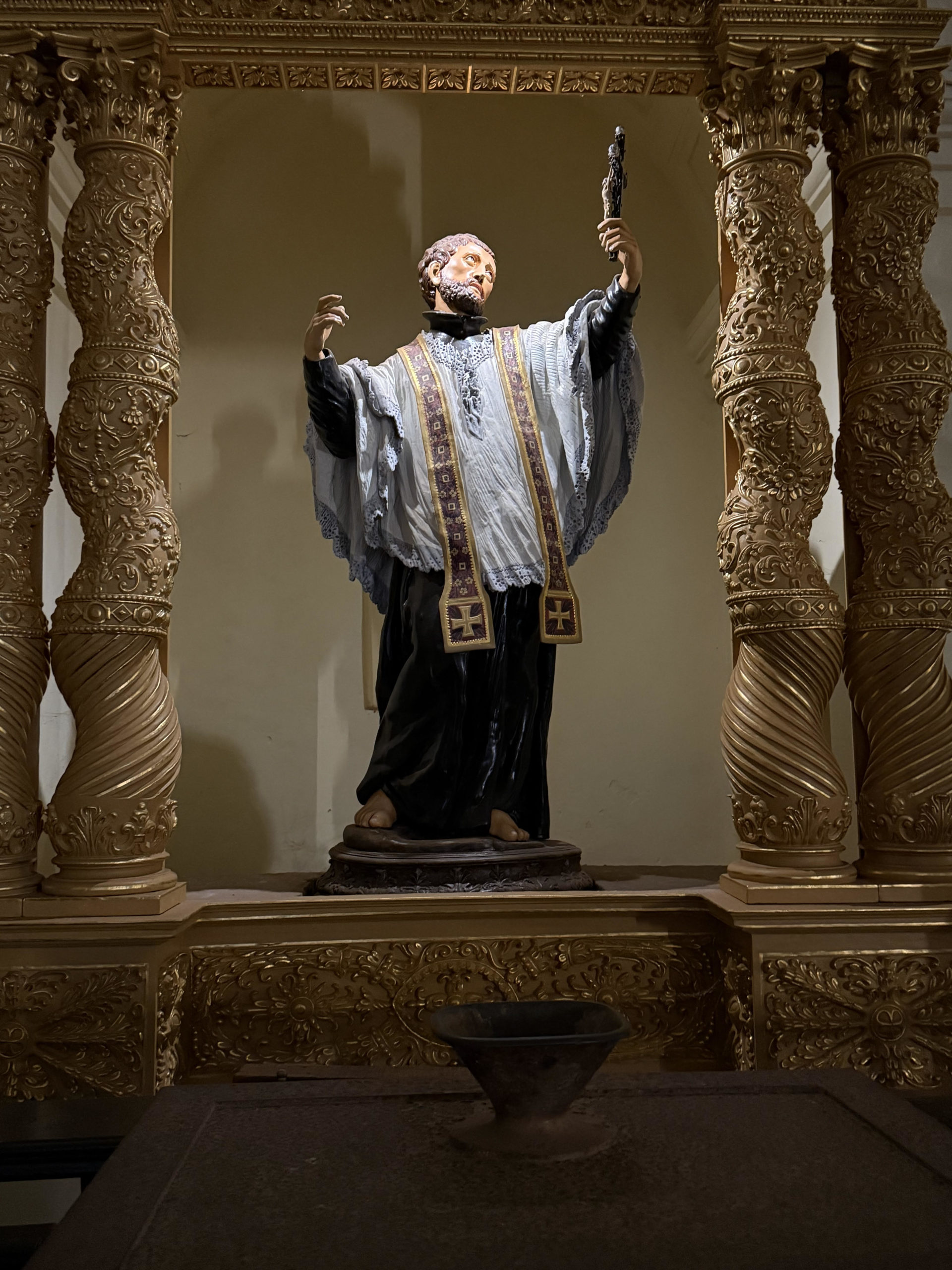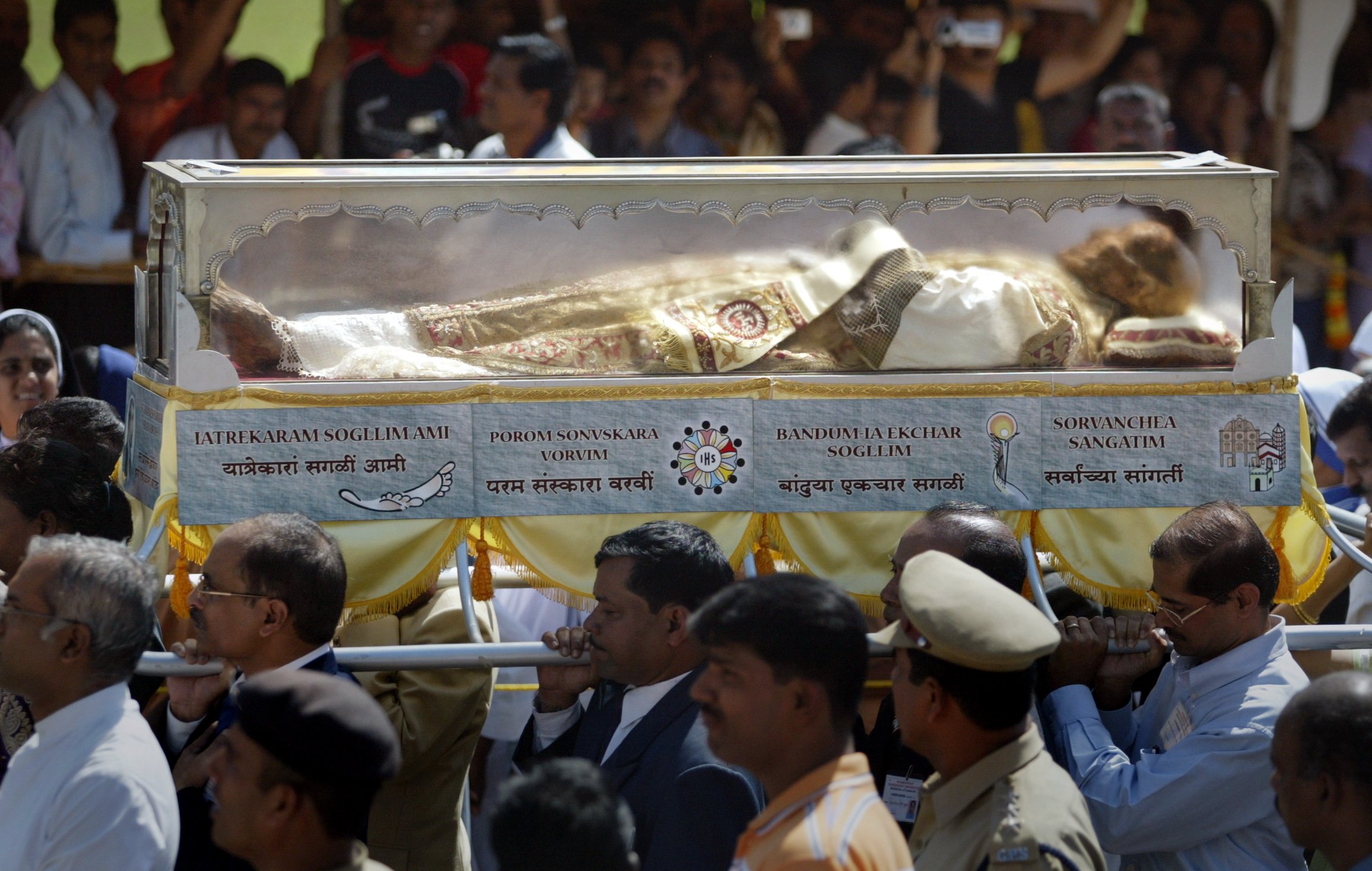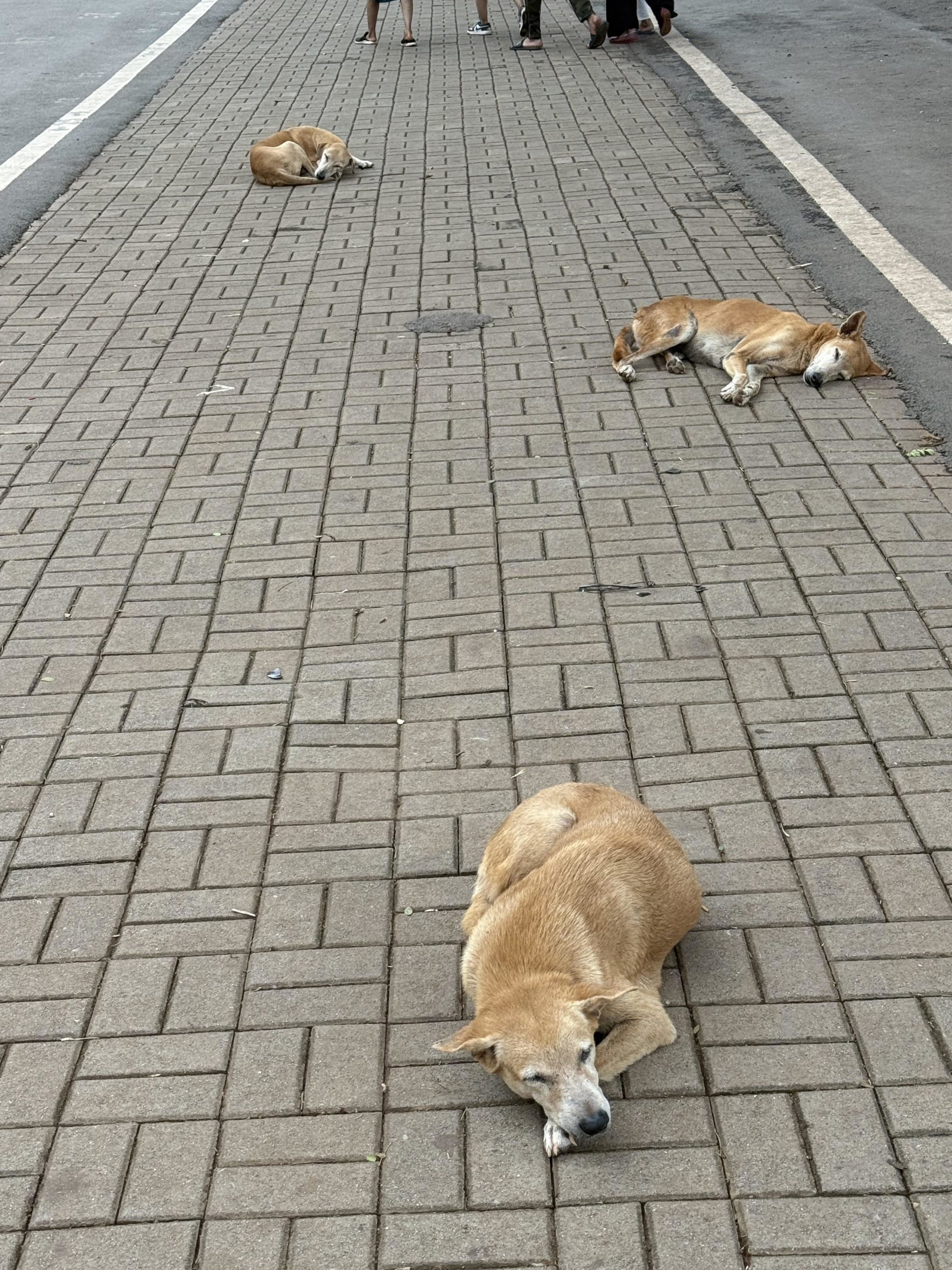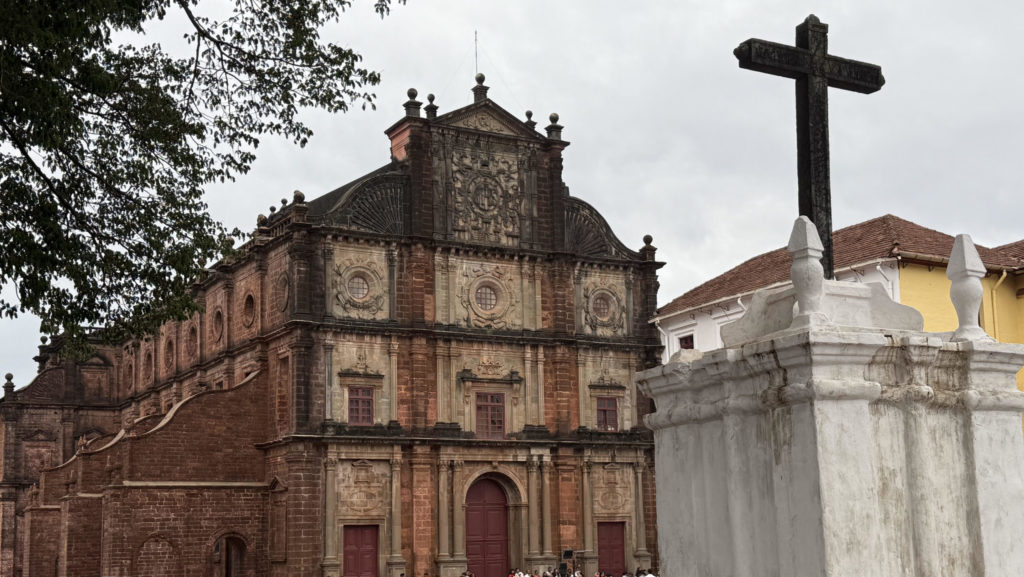“India has two million gods and worships them all. In religion, all other countries are paupers. India is the only millionaire.”
— Mark Twain
Twain, who lectured across India in 1896 during a tour of the British Empire, was off by several million deities in the land that spawned Buddhism, Hinduism, Jainism, and Sikhism millennia before the arrival of Christians and their insistence on One God.
On my 67th birthday, traveling here alone, I prayed the rosary to the Creator of all things seen and unseen on a string of psychedelic beads in a 16th-century church built by the Portuguese.
Along with the Taal Basilica in the Philippines, Goa’s Basilica of Bom Jesus — a 420-year-old pile of black granite — is considered the largest Roman Catholic church in Asia. Inside and out, it is spectacular in a dark and quiet way, almost as if it would prefer to be left alone.
The Basilica — “bom” meaning “good” — is a UNESCO World Heritage Site, more a shrine than a parish, though Mass is celebrated regularly. It was about to close when I arrived early in the evening a few weeks ago. I held up my just-purchased, not-yet-blessed rosary to an usher — beads speckled green and yellow and orange and blue, shining like penny candy — and was allowed to slip into a cordoned-off pew.

It was Saturday and I embarked upon the Joyful Mysteries depicting the Savior’s childhood. It begins with the Annunciation, empowered with the essence of humility spoken by a teenager: “May it be done to me according to Thy word. …”
On one of the beads I said a prayer of thanks that I’d finally made it to the subcontinent after decades of trying. As Saul Bellow wrote, a man can get “held up here for a week, there for a decade. …”
It wasn't until the recent deaths of my parents after several years of elder care that a way was made for me to experience the strange and vivid beauty of India, a land of brilliant color, lush flora, ruins beyond ruin and Hindu rituals found nowhere else on earth.
The adventure started with passage on the Maersk Kinloss cargo ship (where I pocketed an errant rosary in the vessel’s library) from Long Beach to Busan, South Korea. From there, I flew south to Ho Chi Minh City where I gave a talk to a class of second-graders on what the writing life is like. After Vietnam, it was a jump to Kerala in southernmost India on the Malabar Coast, where spices not found in Europe have been traded since about 2,000 BC.
An overnight train from Thiruvananthapuram, the Kerala capital, took me to Goa. Peas, potatoes, and instant coffee for breakfast. The passing countryside, complete with snow white egrets, reminded me of the swamps of Louisiana. At other times, it looked like “Apocalypse Now” if Coppola had dotted the jungle with pink and purple houses alongside statues of the Virgin Mary.
From my hotel in New Goa, I hired a taxi to take me a half-dozen miles to Old Goa. My cabbie, like many in this part of the country, had adorned his dashboard with Catholic sacramentals: rosary beads, small crucifixes, figurines of the Sacred Hearts of Jesus and Mary. One driver had a small sculpture of Michelangelo’s “Pietà” to the left of the steering wheel, which is on the right-hand side of cars in India, as it is in Britain, which ruled the country for two centuries.
Upon arrival, my driver pointed out the entrance. Rising like a fortress beyond large rectangles of golf course-perfect grass dotted with huge banyan trees — the edifice shaded “burnt umber,” the color of a favorite Crayola crayon — lay the object of my ramblings.
From my seat at the far back of the sanctuary — three stories, 183 feet long by 55 feet wide — the splendor of the Faith spread out before me. A dark marble floor embedded with precious stones leads to a trio of altars. Those on each side of the tabernacle are dedicated to St. Michael the Archangel on the right. The other honors Our Lady of Hope.
I’m familiar with many of the honorifics by which the Blessed Mother is known, particularly Our Lady of Lourdes, who intervened in my life for the better in 1990 when I visited her shrine in France. But I did not know that Our Lady of Hope — for whom scores of parishes are named around the world — derives from her 1871 appearance in Pontmain, France, during a Prussian invasion.
In one of the apparitions there to a group of children (her preferred audience), Mary said that “my Son allows Himself to be moved with compassion.” Which is why I pray the rosary.

After making it three-quarters of the way around the beads, another guard leaned in to say they were locking up in three minutes. I made it to the front to stand before Xavier’s tomb for a silent moment.
With all respect to the Savior and his mother, to the right of the 44-foot-high main altar rests the star of this particular show: St. Francis Xavier (1506-1552) under glass and entombed in a silver casket.
One of the great Catholic missionaries, Xavier is said to have converted more than 30,000 people and complained in letters that his arms would get so weary from baptizing people that at times he couldn’t lift them.
In small ways, my journey to the East was not unlike Xavier’s expeditions centuries ago, except that he traveled on foot and wooden ships to spread hallowed stories, while I bobbed across the Atlantic and Pacific on mammoth tubs of steel to collect them. Xavier went from place to place with sacred water and holy oils; I wandered with a notebook and pen, a rosary in my pocket to give away to whoever might cross my path with an interest. Buy one, give it away, replace it, repeat.
Xavier's body — minus his right arm, a relic housed in Rome — is said to be virtually incorruptible. It is exhibited every 10 years on his Dec. 3 feast day before enormous crowds, part of an estimated 4 million annual visitors to the basilica.
Above the altar is a statue of St. Ignatius of Loyola, Xavier’s compañero, fellow Basque and co-founder in 1534 with him of the Society of Jesus. Xavier’s elder by 15 years, Ignatius is shown looking skyward toward a seated, muscular, and bare-chested Christ with a cross over his shoulder like a rifle.
Dividing their missionary routes, Ignatius remained in Europe while Xavier went to the Far East, having said that he wanted to “go where there are out-and-out pagans. …” If he were still with us, I’d direct his zeal to a few bastions of alleged Christianity here in the States. Then again, as a wise man from Argentina famously said a few years ago, “Who am I to judge?”
Xavier brought the Gospel to Japan, Borneo, the Maluku Islands — the Spice Isles — and Shangchuan Island off the Chinese coast, where he died before making it to the mainland.
(I found it poignant that St. Frances Xavier Cabrini (1850-1917) took his name out of her own desire to preach to the Chinese. Sent to minister to Italian immigrants in the 19th-century slums of New York by Pope Leo XIII, Cabrini never made it to China either.)
Before Xavier’s island hopping near China, there was India, where he founded missions in Cochin and Travancore. He landed in 1542 with orders from the Portuguese King John III to bring wayward colonists — not just sailors and merchants but miscreants recruited from prison and the streets — back to the One Holy and Apostolic Church.
Xavier got to India a half-century after Vasco da Gama and the first ships from Lisbon landed in 1498. By then, many of the original settlers were grandparents to children more Indian than Portuguese, their homes following the native customs of the families into which they had married.

Jesus Jimenes, the cabbie who drove me to Bom Jesus, is one of some 21 million people (about 2% of the most populous country on earth) baptized Catholic in India. Pointing out one of the many Catholic churches on the route from New Goa to Old, Jimenes said he attends Mass faithfully. His parents were married in the Faith before 1961, the year that the Republic of India took Goa back from Portugal by force.
It was still a bit light outside when the doors closed behind me. Outside, prostrate on the stone path that divides the lawn leading to the church lay three nearly identical dogs with blonde fur.
It reminded me of the great Joe Cocker 1970 live album “Mad Dogs & Englishmen,” taken from a Noel Coward song mocking the British Empire: “Only mad dogs and Englishmen go out in the midday sun.”
A little research led me to the millions of deities referenced by Twain, back to Yama, the Hindu and Buddhist god of death who guards the road to the afterlife with two dogs. The pair — Sharvara and Shyama — have four eyes each, the better to ensure that wicked men do not sneak into heaven.
In search of cold water, I passed a bewildered beggar on the sidewalk, seated and swaying with his back against a low wall. I’m not even sure he was asking for money, but I passed him a 500-rupee bill — about six bucks — anyway. Immediately, a well-dressed woman approached, soliciting funds, she said, for a local school. The apron she held open was feathered with cash.
I pointed to the man at our feet, a soul who may have benefited in his youth from good schooling or any at all. “Already gave,” I said. She frowned, as though I had flushed the money down a toilet, and moved on.
The following evening in Mumbai, the trip abruptly ended when a cluster of bacteria exploded in my guts. I rushed home to great concern, a trip to the hospital, a call from the local health department wanting to know where I’d been, and a few “I told you so” from loved ones who’d questioned the prudence of the trip before it began.
None of it was easy, not by a stretch. And though I would not have said this when a trio of E. coli in league with a norovirus took me down in Room 403 of the Mumbai Airport Holiday Inn, I’ll say it now.
I want to go back and finish the rosary I began as the sun began to set behind the Basilica Bom Jesus in the Land of the Golden Bird.
Editor's note: A previous version of this essay incorrectly stated that Mark Twain had never visited India. We regret the error.

